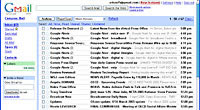 A year after its launch, Google has doubled the capacity of its Gmail service and added new features.
A year after its launch, Google has doubled the capacity of its Gmail service and added new features.
Those lucky souls invited to have an account now get a whopping great 2GB of storage, with the ability to send up to 10MB of attachments in a single message with free POP access – with Google promising further increases in the pipeline.
“Since we introduced Gmail, people have had a lot of places to store e-mail, but some of our heavier users have been approaching their limits, and have been wondering what is going to happen,” says Georges Harik, Gmail’s product management director. “So, starting today, we are going to give people more and more space continuously and indefinitely.”
“Our plan is to continue growing your storage beyond 2GB by giving more space as we are able to do so. We know that email will only become more important in people’s lives, and we want Gmail to keep up with our users and their needs.”
The move comes hot on the heels of last week’s decision by Yahoo to increase the size of its free account to 1GB. Both Yahoo and Hotmail can offer up to 2GB of storage as well, but users must fork out for the privilege.
The company has announced no immediate plans to increase Gmail’s 10MB limit on attachment sizes, and there’s no prospect of subscribers being able to turn their in-box storage into a full-featured virtual external hard disk.
 Google is, however, aware that some crafty Gmail subscribers are using the service for this purpose, mailing files to themselves as a way of storing them online.
Google is, however, aware that some crafty Gmail subscribers are using the service for this purpose, mailing files to themselves as a way of storing them online.
Google seems cool about it too, with Harik saying, “We want our users to understand that we have a plan and that we are anticipating their needs, and that nothing strange is going to happen with Gmail down the line.”
Google is also testing phishing protection on the accounts, serving up a warning when it detects a dodgy looking email.
Gmail’s arrival on the scene a year ago sent up a rocket up the backsides of the Web mail market, whose main players had been providing minimal inbox storage for their free services.
At the time, Yahoo only offered a paltry 4MB of in-box with Microsoft providing even less at 2MB.
Since then, most major Web mail providers have reacted to Gmail’s generous inbox quotas with Microsoft and Yahoo both now offering 250MB for their free services. Yahoo plans to begin offering 1GB starting in late April.
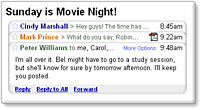 Curiously, Gmail is still technically in a beta phase, and is not generally available – the only way users can obtain a Gmail account is by invitation from an existing user (each current user has 50 invitations to give).
Curiously, Gmail is still technically in a beta phase, and is not generally available – the only way users can obtain a Gmail account is by invitation from an existing user (each current user has 50 invitations to give).
Google also randomly offers Gmail accounts via its main Google.com Web page.
Google have yet to clarify whether Gmail accounts would ever be totally open, with Harik cryptically commenting, “We keep looking for ways to make it more broadly available to people who want to use it”.
While Gmail is totally free to use, it’s financed by text ads that are served up to users with each message they open. The fact that the ads are based on each message’s text caused an outcry, but Google insist that text scanning is automated and without nosey human intervention.
 Vodafone Netherlands have added two further ‘channels’ to their current 20 plus channel UMTS (3G) service.
Vodafone Netherlands have added two further ‘channels’ to their current 20 plus channel UMTS (3G) service.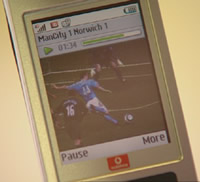 To date, Vodafone has EuroSport and RTL Nieuws exclusively and their addition brings the total number of TV channels available to 23, joining CNN, Playboy Channel, 2GOTV and MTV.
To date, Vodafone has EuroSport and RTL Nieuws exclusively and their addition brings the total number of TV channels available to 23, joining CNN, Playboy Channel, 2GOTV and MTV. The London Underground is to show digital advertising on its escalators for the first time, as part of a trial being handled by Viacom Outdoor.
The London Underground is to show digital advertising on its escalators for the first time, as part of a trial being handled by Viacom Outdoor. The trial is due to start within months, and if successful will be rolled out at other locations across the network.
The trial is due to start within months, and if successful will be rolled out at other locations across the network. Everyone’s heard of Space Invaders haven’t they? Those who haven’t, will surely have been sitting in a very dark room with their fingers in their ears, singing “La, la, la, la” very loudly to themselves since 1978.
Everyone’s heard of Space Invaders haven’t they? Those who haven’t, will surely have been sitting in a very dark room with their fingers in their ears, singing “La, la, la, la” very loudly to themselves since 1978. Not wanting to let a good thing go by, Nintendo has announced the latest version of Invaders – Space Invaders Revolution for the Nintendo DS.
Not wanting to let a good thing go by, Nintendo has announced the latest version of Invaders – Space Invaders Revolution for the Nintendo DS. The new version sounds like it has some of those interesting features, such as rules that change as you pass between levels.
The new version sounds like it has some of those interesting features, such as rules that change as you pass between levels. In normal play, the DS version doesn’t make a great use of the dual screens. You can use the lower, touch screen as a controller, tapping the on-screen buttons, in some of the games and sometimes graphics do pass between the two.
In normal play, the DS version doesn’t make a great use of the dual screens. You can use the lower, touch screen as a controller, tapping the on-screen buttons, in some of the games and sometimes graphics do pass between the two.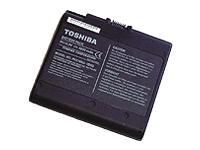 Toshiba has developed a super-fast Lithium-Ion battery capable of being charged to 80 per cent of its full capacity in under 60 seconds. According to the company, a full charge takes just “a few more minutes”.
Toshiba has developed a super-fast Lithium-Ion battery capable of being charged to 80 per cent of its full capacity in under 60 seconds. According to the company, a full charge takes just “a few more minutes”.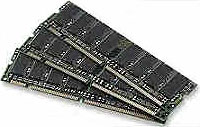 The 512Mb XDR (extreme data rate) DRAM chips run at a turbo-charged speed of 4.8GHz, which is about 12 times faster than that of the memory typically found in today’s desktop PCs.
The 512Mb XDR (extreme data rate) DRAM chips run at a turbo-charged speed of 4.8GHz, which is about 12 times faster than that of the memory typically found in today’s desktop PCs. In a shocking example of virtual life crashing into real life, a Shanghai online game player stabbed his gaming pal in the chest multiple times after he learned that he had stolen approximately US$870 (£462/€671) from the sale of a powerful “dragon sabre”, jointly owned by both players.
In a shocking example of virtual life crashing into real life, a Shanghai online game player stabbed his gaming pal in the chest multiple times after he learned that he had stolen approximately US$870 (£462/€671) from the sale of a powerful “dragon sabre”, jointly owned by both players.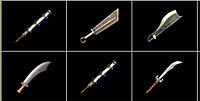 Still fuming, Chengwei popped around to have a word with Caoyuan who didn’t convince with his promises to pay him for the sword.
Still fuming, Chengwei popped around to have a word with Caoyuan who didn’t convince with his promises to pay him for the sword. However, online game companies in Shanghai – the city with the most players – are planning to set up a dispute system where aggrieved players can find recourse.
However, online game companies in Shanghai – the city with the most players – are planning to set up a dispute system where aggrieved players can find recourse. Microsoft has launched MSN Video Downloads, a spanking new mobile service that will provide daily television programming for downloading to Windows Mobile devices, such as Portable Media Centers, Smartphones and Pocket PCs.
Microsoft has launched MSN Video Downloads, a spanking new mobile service that will provide daily television programming for downloading to Windows Mobile devices, such as Portable Media Centers, Smartphones and Pocket PCs. The video content is compliant with ‘PlaysForSure’ video devices, and is optimised for Portable Media Centers and compatible with Smartphones and Pocket PCs that support Windows Media Player 10 Mobile.
The video content is compliant with ‘PlaysForSure’ video devices, and is optimised for Portable Media Centers and compatible with Smartphones and Pocket PCs that support Windows Media Player 10 Mobile. “With content from some of the most recognized brands in entertainment, MSN Video Downloads helps bring this vision to life, allowing people to take their favourite television shows with them whether they are on the train, waiting for a doctor’s appointment, or keeping the kids occupied in the back seat of the car.”
“With content from some of the most recognized brands in entertainment, MSN Video Downloads helps bring this vision to life, allowing people to take their favourite television shows with them whether they are on the train, waiting for a doctor’s appointment, or keeping the kids occupied in the back seat of the car.” All music videos on the site will be made available in multiple formats for playing on traditional PCs, laptops and Microsoft’s Windows Mobile-based secure devices including the Portable Media Centers, Pocket PCs and select Smartphones.
All music videos on the site will be made available in multiple formats for playing on traditional PCs, laptops and Microsoft’s Windows Mobile-based secure devices including the Portable Media Centers, Pocket PCs and select Smartphones. Last week, deputy Director-General Mr Broesterhuizen of the Dutch ministry of Economic Affairs officially opened the Netherland’s largest Fiber-to-the-Home (FttH) network in Nuenen, a village in the south of The Netherlands.
Last week, deputy Director-General Mr Broesterhuizen of the Dutch ministry of Economic Affairs officially opened the Netherland’s largest Fiber-to-the-Home (FttH) network in Nuenen, a village in the south of The Netherlands. By summer 2005, approximately 16,000 FttH connections will be up and running in the Kenniswijk area, with over “100 innovative services” being developed, of which 50 are already available.
By summer 2005, approximately 16,000 FttH connections will be up and running in the Kenniswijk area, with over “100 innovative services” being developed, of which 50 are already available. As of early May, Dutch Vodafone customers will be able to say ‘nr!’ to saucy adult content offered via Vodafone live! from their mobile phone.
As of early May, Dutch Vodafone customers will be able to say ‘nr!’ to saucy adult content offered via Vodafone live! from their mobile phone.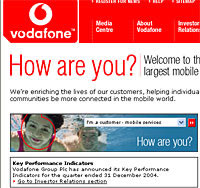 With hand-rubbing porn-shifters keenly eying up a growing – and lucrative – mobile multimedia market, it makes sense for telcos to be able to reassure parents that young Timmy’s new handset isn’t going to become a mobile gateway into the portals of smut.
With hand-rubbing porn-shifters keenly eying up a growing – and lucrative – mobile multimedia market, it makes sense for telcos to be able to reassure parents that young Timmy’s new handset isn’t going to become a mobile gateway into the portals of smut. Memory card kings Lexar Media have teamed up with videogame big boys, Ubisoft, in a cunning piece of cross-market publicity.
Memory card kings Lexar Media have teamed up with videogame big boys, Ubisoft, in a cunning piece of cross-market publicity.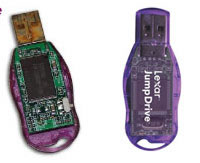 Described as a “major value-add promotion” it looks more like the unexciting equivalent of a magazine freebie cover disk to us, but Theresa Boldrini, Lexar Director of Retail Marketing, can’t hold back her excitement:
Described as a “major value-add promotion” it looks more like the unexciting equivalent of a magazine freebie cover disk to us, but Theresa Boldrini, Lexar Director of Retail Marketing, can’t hold back her excitement: And if all that wasn’t enough, a special Lexar promotion will offer consumers a free Tom Clancy’s Splinter Cell Chaos Theory t-shirt with the purchase of another Lexar product (be still my bearing heart!).
And if all that wasn’t enough, a special Lexar promotion will offer consumers a free Tom Clancy’s Splinter Cell Chaos Theory t-shirt with the purchase of another Lexar product (be still my bearing heart!).